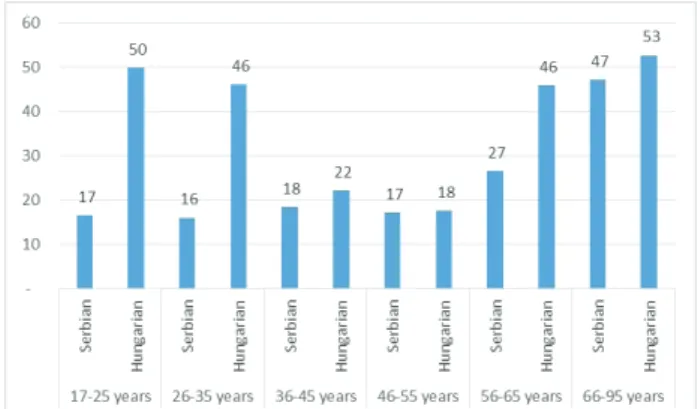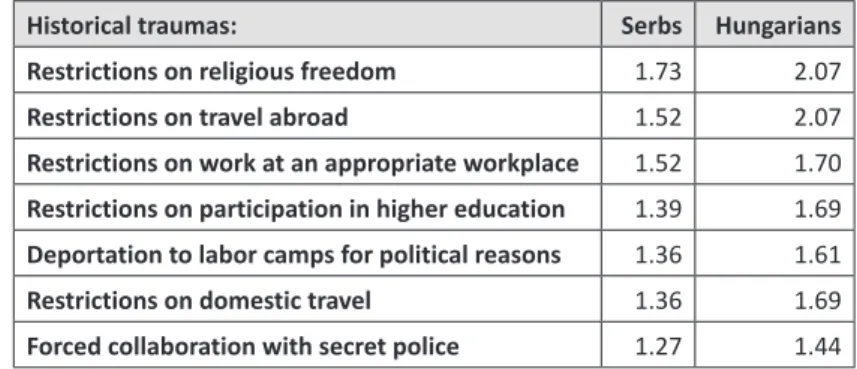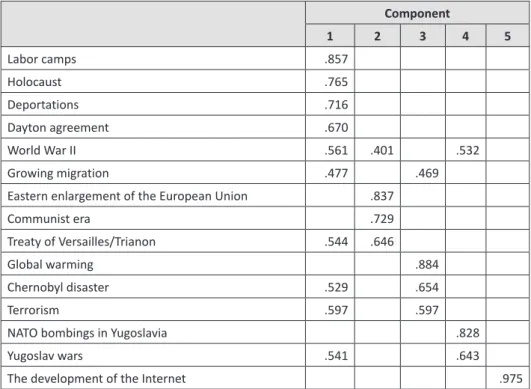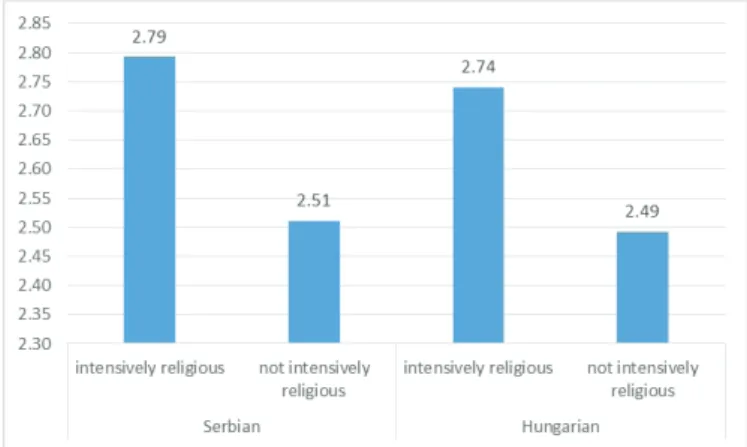UDC:316.482:323.15(497.113) 316.482:[316.7:159.953.3(497.113)
ETHNICITY, RELIGIOSITY AND MEMORY A CASE STUDY IN VOJVODINA, SERBIA
Tóth- Máté, András, Prof. PhD, DSc1 Lencsés, Gyula, PhD, Ass. Prof.2 Paizs, Melinda Adrienn, PhD candidate3
Abstract: The general question under investigation in this study are the different effects of religiosity and religious affiliation, combined with ethnicity, on social coexistence in Central and Eastern Europe and especially in the Balkan region. The question is of enormous importance at a time of high individuality and pressures against social cooperation and peace. Recent data collected in Vojvodina in 2018 is analyzed with a variety of statistical methods. In the statistical analysis, first, a distinction is made between religiosity and ethnicity and the relationship between religiosity and ethnic affiliation is evaluated. Then correlations between religiosity and ethnic sensibility are examined. Ethnic sensibility is measured as ascribing high importance towards historical and political issues.
The problematics of the ethnic tensions has a long tradition in Vojvodina and in the entire Balkan region. The centuries long lack and desire for an autonomous and sovereign national state characterizes the region. And especially the Balkan war in the early 1990s impregnates the attitudes of the population of all ethnicities.
Memory politics and memory war play an important role in contemporary politics and public discussions. All these aspects of the contemporary Vojvodina deserve a closer attention.
Keywords: religion, ethnicity, historical traumas, Vojvodina, Serbs, Hungarians
1 University of Szeged, Hungary, matetoth@rel.u-szeged.hu
2 University of Szeged, Hungary, lencses@socio.u-szeged.hu
3 University of Szeged, Hungary, melinda.adrienn.paizs@gmail.com
1. Introduction
In the scholarly literature concerning the population of the Balkans, the two dimensions of ethnicity and religiosity are mentioned often not separately but as a stable idiom. (Dingley & Catterall, 2020; Ramet, 2018; Stamenova, 2017) This routine goes back to the historical evidence of the highly overlapping nature of ethnicity and denomination.
The Serbs are Orthodox Christians, Croats are Roman Catholics, Hungarians are Catholics and Calvinists, Bosnians are Muslim from a historical point of view. (Bremer, 2008) Although this kind of historical evidence has some relevance in understanding the recent social processes, religiosity does not depend only on affiliation with a particular ethnicity anymore. In modern times religiosity is rather a subjective decision than a characteristic that can be taken for granted following tradition. Similarly, the importance of ethnic affiliation is determined only partially by tradition: it is partially the result of personal decisions. Therefore, it makes sense to analyze these two dimensions, ethnicity and religiosity, separately. (Tomka, 2011)
The general question that interested us in this study are the various effects of religiosity and religious affiliation, combined with ethnicity, on social coexistence in Central and Eastern Europe and especially in the Balkan region. The question is of enormous importance at a time of high individuality and pressure against social cooperation and peace. (Mälksoo, 2015)
So, in our statistical analysis, first of all, we make a distinction between religiosity and ethnicity and evaluate the relationship between religiosity and ethnic affiliation.
(Tomka & Szilárdi, 2016)
Then, we focus on the correlation between religiosity and ethnic sensibility. We measure ethnic sensibility as ascribing high importance towards historical and political issues. The problematic of the ethnic tensions has a long tradition in Vojvodina, and in the entire Balkan region.4 The century long lack and desire for an autonomous and sovereign nation state characterizes the region. And especially the Balkan war in the early 1990s impregnated the attitudes of the population of all ethnicities. Memory politics and memory war play an important role in contemporary politics and public discussions. All these aspects of the contemporary Vojvodina deserve a closer attention.
Two types of ethnically sensitive questions promised possible new insights for our questionnaire: on the one hand, those regarding the differential importance of global and local historical facts, and, on the other hand, those concerning the differential importance of ethnic tensions for Serbs and Hungarians in Vojvodina. Our preliminary hypothesis is that strong religiosity has a higher impact on memory and ethnic sensitivity than affiliation with a particular ethnicity does.5
4 It is a geographical, historical and cultural question whether Vojvodina belongs to the Balkans or not. For the present paper it demands attention only because of the limits of the relevance of the findings for the entire Balkan region.
5 This research was supported by the project (EFOP-3.6.2-16-2017-00007) entitled “The development of intelligent, sustainable and inclusive society: Social, technological, innovation
2. Data and methods
We collected data in Vojvodina at the end of 2018 (between November 14 and December 25) in collaboration with the Center for the Empirical Research of Religion (CEIR), chief editor Zorica Kuburić (University of Novi Sad). The size of our random sample (N=1,043) is sufficient for a detailed analysis of the population in Vojvodina.
7. 3. Religiosity and ethnicity: Statistical results
As an indicator of ethnic affiliation, we used the mother tongue of the respondents, cf. Table 1:
Table 1. Ethnic distribution of the respondents
N %
Serbian 785 76%
Hungarian 146 14%
Slovak 10 1%
Romanian 18 2%
Roma 9 1%
Macedonian 5 1%
Croatian 24 2%
Other 32 3%
Total 1,029 100%
Denominational distribution is various with a dominance of Serbian Orthodox and Roman Catholics (Table 2).
Table 2. The distribution of denominations in the sample
N %
Serbian Orthodox 653 67%
Romanian Orthodox 24 2%
Roman Catholic 169 17%
Greek Catholic 6 1%
Mainstream Protestant 45 5%
networks in employment and the digital economy”. The project has been supported by the European Union and co-financed by the European Social Fund and the budget of Hungary.
Jewish 2 0%
Islamic 14 1%
Adventist 39 4%
Evangelical 5 1%
Pentecostal 2 0%
Other 22 2%
Total 981 100%
Below focus only on the main ethnic groups and main denominations of Vojvodina, selecting only five groups, as can be seen in Table 3. These five groups constitute 84% of our total sample.
Table 3. The main groups based on ethnicity and denomination
N %
1 Serbian, Orthodox 632 76%
2 Serbian, Catholic 39 5%
3 Hungarian, Catholic 97 12%
4 Hungarian, Protestant 31 4%
5 Croatian, Catholic 22 3%
Total 821 100%
For religiosity we differentiated between two groups, an intensively religious group and a non-intensively religious group, the latter including non-religious people, as well.
We define the intensively religious group as praying weekly or more often, spending time on going to church weekly or more often, and believing in God without doubt.
The proportion of intensively religious people in our sample is one quarter (Table 4).
Table 4. Proportion of intensively religious people
N %
Intensively religious 261 25%
Other 774 75%
Total 1,035 100%
When comparing the two main ethnic groups in our sample, we see a higher proportion of intensively religious people among Hungarians than among Serbs (cf. Table 5).
Table 5. Distribution of intensively religious people in the Serbian and Hungarian ethnic groups Intensively religious
Total
Yes No
Mother tongue
Serbian N 158 622 780
% 20% 80% 100%
Hungarian N 56 90 146
% 38% 62% 100%
Total N 214 712 926
% 23% 77% 100%
This difference may be due to the different age distribution of Hungarians and Serbs in our sample. So, first of all, we examine the connection between religiosity and ethnicity by age cohorts. We distinguish six age cohorts (Figure 1). As we can see, the difference in intensive religiosity between Serbs and Hungarians is significant only by the second oldest (56-65 years) and the two youngest cohort (35 years, or younger).6
Figure 1. Proportion of intensively religious people in the ethnic groups by cohorts (%)
In the Serbian group the proportion of intensively religious people is at a constant low level under the age of 55, and this increases in the two oldest cohorts. We find a different pattern among Hungarians: they have a defd in other cases in interaction with each other and so on.
It means, consequently, that we cannot predict the intensity of religiosity merely from denomination. This also means that it can affect the attitudes of the respondents in various combinations: in some cases, independently and in other cases in interaction with each other and so on.
6 We use p=0.05 as the significance level all throughout our paper.initely large proportion in the two oldest (56 years or older) and two youngest cohorts (35 years or younger), too.
3. Ethnic sensitivity and religiosity
Below we concentrate on issues about ethnic sensitivity and their dependence on the intensity of religiosity and affiliation with the different ethnic groups. As has already been mentioned, ethnic sensitivity is measured by items related to historical facts or processes referring to or involving ethnical tensions. People for whom the memory of local historical facts and ethnic tensions is more important have a higher ethnic sensitivity.
It is important to highlight that this type of sensitivity tells nothing about the meaning of the concrete items. We try only to reveal the interdependence between religiosity and ethnic sensitivity without evaluating the statements included in our questions about historical facts or ethnic tensions.
3.1. Historical traumas experienced by the Hungarian minority and Serbian majority
We asked questions concerning the suffering of people living in Serbia in different historical periods, like during the WW2, during the communist period, and after the Balkan war. We have found significant differences between Serbs and Hungarians:
Hungarians are more likely to have experienced these types of traumas.
For the items concerning the communist era we used the model of the questionnaire of Life of Transitions Survey (LiTS) III. from 2015–2016.7
Table 6. The importance of historical traumas experienced by Serbs and Hungarians
Historical traumas: Serbs Hungarians
Restrictions on religious freedom 1.73 2.07
Restrictions on travel abroad 1.52 2.07
Restrictions on work at an appropriate workplace 1.52 1.70 Restrictions on participation in higher education 1.39 1.69 Deportation to labor camps for political reasons 1.36 1.61
Restrictions on domestic travel 1.36 1.69
Forced collaboration with secret police 1.27 1.44
Another group of our questions concentrates on ethnic tensions between Hungarians and Serbs in general, in Vojvodina, and in the respondents’ own locality. Concerning
7 “The third round of the Life in Transition Survey (LiTS III) was conducted between the end of 2015 and the beginning of 2016 in 34 countries, comprising 29 transition countries, the Czech Republic and two western European comparator countries (Germany and Italy). Cyprus and Greece were also covered for the first time. The survey was implemented by the EBRD and has benefited from the joint collaboration with Transparency International and the World Bank.”
(https://litsonline-ebrd.com/methodology-annex/- last visited on 03. 24. 2020)
these items there is no significant difference between Serbs and Hungarians in general, but in the case of their own locality there are significant differences. Serbs have higher sensitivity than Hungarians in Vojvodina as a whole and in their smaller locality, too.
(Figure 3).
Figure 2. “How much do you agree with these statements?”
(Means by ethnic groups. Higher means indicate higher agreement.)
We have significant differences only regarding the items about the condemnation of the ‘other’ ethnic group and about forgiveness. The questions were formulated as follows:
• “Hungarians in Vojvodina should be ashamed of the atrocities and crimes against the minorities.”
• “Hungarians and the other minorities in Vojvodina should try to forgive the sufferings and should show understanding.”
Serbs have higher means at these two items than Hungarians. But in case of the second statement regarding forgiveness the difference between Serbs and Hungarians is small.
Figure 3. “How much do you agree with these statements?”
(Means by ethnic groups. Higher means indicate higher agreement.)
3.2. Differences in memory of historical events
In the next analytical step, we asked people to evaluate the importance of historical events, some global, others local. The list of the historical facts we use is from the World History Survey (Liu et al. 2005 and 2009), and we added some historical items referring to the local history in the Balkans and especially in Vojvodina. Based on the works of Liu et al. we share their argument that the importance of historical facts among the members of a population indicate a kind of historical sensibility of that population, and they are probably a decisive part of their contemporary collective identity.
Figure 4. Importance of historical facts (Means by ethnic groups.
Higher means indicate higher importance)
The top six items have an importance level higher than 3.0 for both ethnic groups.
The Treaty of Versailles (1920) seems to be important for the Hungarians only.
Figure 5. Differences of means regarding the importance of various historical facts
The differences in the importance of these items between Serbs and Hungarians form an interesting picture. For Serbs the three most important historical facts are more than 50 years old. In contrast, for Hungarians the most important historical events are from more recent years. The only exception is the Treaty of Versailles (asked in the questionnaire with the Hungarian terms as the Treaty of Trianon).
One group of the items in the questionnaire is about global issues: the development of the Internet, collaboration in the communist era, EU enlargement, World War II, the Holocaust, and terrorism. Almost all these issues have a significantly higher importance in the intensively religious group than in the other one. In the case of the NATO bombings, the difference is not significant. All issues are more important for the older age cohorts, except the development of the Internet, which is more important for the younger cohorts.
Using principal component analysis for the importance of these historical facts and events, we found five principal components.
Table 7. Principal components for the importance of historical events and processes Rotated Component Matrixa
Component
1 2 3 4 5
Labor camps .857
Holocaust .765
Deportations .716
Dayton agreement .670
World War II .561 .401 .532
Growing migration .477 .469
Eastern enlargement of the European Union .837
Communist era .729
Treaty of Versailles/Trianon .544 .646
Global warming .884
Chernobyl disaster .529 .654
Terrorism .597 .597
NATO bombings in Yugoslavia .828
Yugoslav wars .541 .643
The development of the Internet .975
The first component includes main historical traumas like deportation to labor camps, the Holocaust etc. (Traumas). The second group consists of items involving change in the main political structures and systems, like the EU enlargement, communism, and Dayton
(Political structure). The third main component is about global dangers (e.g. global warming and the Chernobyl disaster) (Global dangers). The fourth group of variables relates to the wars in the Balkan region (Wars). The development of the Internet is separated in the last main component (5).
Below we concentrate on the historical traumas only. For the traumatic past of the entire Central and Eastern European region Máté-Tóth composed a special list of five main traumas and called them the five wounds of the collective identity. (Máté- Tóth, 2019) These are (1) the insecurity of state borders, (2) the prohibition of using of minority languages, (3) forced and forbidden mobility, (4) the persecution of religion, churches and dissidents, and finally (5) the Holocaust and other mass murders. In the following model we focus on the typical traumas caused by the totalitarian communist regimes. Although for all items the no answers are more typical than the yes answers, all issues were experienced more deeply by Hungarians than by Serbs.
Investigating the various age cohorts, we found that there are no significant differences between them, which means that the memory on these traumatic experiences was passed down to the younger generations.
Figure 6. Presence of historical traumas in the respondents’ families and neighborhoods. Means by age cohorts. Higher means indicate higher presence
Finally, we examine the separated and combined effect of ethnicity (i.e. Serbian or Hungarian) and religiousness (i.e. intensively religious or not) to the perceived importance of the various historical items in our questionnaire. We use a multiple analysis of variance (MANOVA) to detect the significance of these two main effects and the interaction between them. From the long list of general and local historical issues we show only some, where religiosity has a higher impact than affiliation with a certain ethnicity, which was measured by the mother tongue of the respondents.
The importance of the communist period is influenced by religiosity only. Intensively religious groups have greater means regardless of their ethnicity (Figure 8).
Figure 7. Importance of the communist period by religiosity and ethnicity (Means)
Yugoslav wars: We have significantly greater means among intensively religious people than in the other group, and greater mean among Hungarians than among Serbs.
These two factors (ethnicity and religiosity) increase the importance of Yugoslav wars independently.
Figure 8. Importance of the Yugoslav wars by religiosity and ethnicity (Means)
In case of the restrictions on religious freedom there is an interaction between religiosity and ethnicity. In the Serbian population, intensively religious people experienced more restriction of the right to be religious. In the Hungarian ethnic group, in contrast, not intensively religious people perceived this disadvantage to a greater extent.
Figure 9. Importance of the prohibition of practicing religion by religiosity and ethnicity (Means)
With these examples we intend to show that the impact of ethnicity and intensive religiosity on different issues can vary. In some cases, only one of them has a significant effect, in other cases they can have an independent impact, and sometimes intensive religiosity can increase or diminish the ethnic differences.
Conclusion
The First Conference for Dialog and Reconciliation between Religions has the main aim to analyze the religious and cultural resources for a better coexistence in the Balkan region and in other cultural areas of Europe. In our analysis we investigated the impact of ethnic and religious factors on the perception of the importance of common history in the multinational and multireligious region of Vojvodina in Northern Serbia. We found that ethnicity and religiosity do not have always the same impact. Affiliation with a particular ethnicity usually means membership in a particular denomination. However, nowadays people are free to hold different standpoints on different issues regardless of their denominational affiliation.
In our study we have concentrated more on the groups defined by different intensity of religiosity. According to our results, in Vojvodina the perceived importance of global historical facts is not influenced significantly by religiosity or ethnicity.
In the cases of local history, the picture is slightly different. The importance of the Balkan War is greater in intensively religious groups in both ethnic groups. And the intensive religiosity has a higher impact on the perceived importance of the period
of communism than the ethnicity. On the other hand, on issues like deportation, labor camps there are no differences either by ethnicity or by religiosity.
Intensive religiosity also can play an extraordinarily important role in reconciliation.
By defining of the intensity of religiosity we used not only the indicators of private religiosity like strong faith in God or praying very often, but also the social dimension of religiosity, i.e. the time spent at church. This social dimension of religiosity raises the question about the role and responsibility of religious institutions, especially the role of teaching, that is, kerygma. When people regularly visit the church and enjoy the sermons of the priests in both confessions, Catholic or Orthodox, they can play a decisive role in the healing of the memories of communism and the Balkan wars. In our analysis, we can only argue for the importance of memory and for the high impact of intensive religiosity on memory. But we have not analyzed the direction of this impact: a positive impact, towards peace, or a negative one, deepening tensions. It depends on the content of intensive religiosity or, in other words, on the religious discourse of the churches. The analysis of this issue will clearly require further investigations.
References
Bremer, T. S. (Ed.). (2008). Studies in Central and Eastern Europe. Religion and the conceptual boundary in Central and Eastern Europe: Encounters of faiths. Palgrave Macmillan.
Dingley, J., & Catterall, P. (2020). Language, religion and ethno-national identity: the role of knowledge, culture and communication. Ethnic and Racial Studies, 43(2), 410–429.
Mälksoo, M. (2015). ‘Memory must be defended’: Beyond the politics of mnemonical security. Security Dialogue, 46(3), 221–237.
Máté-Tóth, A. (2019). Freiheit und Populismus. Springer Fachmedien Wiesbaden.
https://doi.org/10.1007/978-3-658-25485-8
Ramet, S. P. (2018). Balkan Babel: The disintegration of Yugoslavia from the death of Tito to the fall of Milosevic. Routledge.
Stamenova, S. (2017). The specifics of Balkan ethnic identity construction:
ethnicisation of localities. National Identities, 19(3), 311–332.
Tomka, M. (2011). Expanding religion: religious revival in post-communist Central and Eastern Europe. De Gruyter.
Tomka, M., & Szilárdi, R. (2016). Religion and Nation. In A. Máté-Tóth & G. Rosta (Eds.), Focus on Religion in Central and Eastern Europe: A Regional View (pp. 75–110).
Walter de Gruyter GmbH & Co KG.









